England Pt. 2
Waking up in the Cotswolds
This mornings English breakfast had a twist, it included black pudding, when Norine ordered hers without bacon and sausage, the girl came back with a warning. "If you don't eat meat you probably won't want black pudding, it's made with pigs blood"... mmmm, yum. I had to taste a corner of it, but that was more than enough, I've had haggis and blood pudding now, I'm so cultured.

When you're packing your bags for a long trip, you don't want to be carrying around five weeks worth of clothes, so it makes sense to plan for a week or so worth of clothes, and do laundry along the way. You can find a do-it-yourself laundry, but to make the best of your time, find a drop-off laundry lets you be tourist for the day and pick it up later.
The best part of our touring around today, is while we are driving, someone else is doing our laundry, and our hotel is only charging us 6£. Clean clothes will be waiting in our room for us.
With Chipping Campden as our base, we would explore the other villages of the Cotswolds, starting with Broadway. Originally a stagecoach stop, Broadway's thatch roof houses and honey coloured stone buildings make it fit right in with the Cotswolds village style.
Just outside of town is the Broadway Tower, The "Saxon" tower was built for Lady Coventry in 1799 to resemble a mock castle, but really just meant to be a beacon, lit for special occasions. After wandering the town, and finding the tower in the pouring rain, it's time to move on.
Dating back over 1200 years, Stanway House is a Jacobean manor house. The present day owner opens his house twice a week for visitors to explore, sadly we find out that today isn't one of those days. The house is closed, they are doing a blood clinic, so we sneak around the outside to see the house and it's unique grounds, ponds and fountains before heading to the next stop.
The next Cotswold stop is the village known as Stow-on-the-Wold. At the center of the market square is medieval stocks, where criminals were locked up to face public ridicule as punishment.
Even more interesting is the Wool Church dating back to Saxon times, not because of the church itself, which is nice, but at the back of the church is a unique door. Two ancient yew trees surround the door, they are thought to be the inspiration for J.R.R. Tolkien's 'door into Moria' from the Lord of the Rings book. Tolkien was known to have hiked the Cotswolds prior to writing his book.
From Stow-on-the-Wold we head to Bourton-on-the-Water, the town known as 'Venice of the Cotswolds'. It's named that because of the many bridges crossing the shallow river that runs through the town. There is lots of ducks in this town, and the weather is suited for them.
The Church of St Lawrence in Bourton-on-the-Water has a beautiful carved Chancel from 1392. After wandering in the rain through quaint village towns, it was time to go more majestic.
We left BotW, and headed to Blenheim Palace - home to the Duke and Duchess of Marlborough and the birthplace of Sir Winston Churchill. The Palace was created as a gift to the First Duke of Marlborough, who successfully led the Allied forces into battle in 1704. When the First Duchess fell out of favour with the Queen, Royal funds for the Palace dried up. Building of the Palace came to a halt in the summer of 1712. Eventually the Palace was completed at the Duke’s own expense.
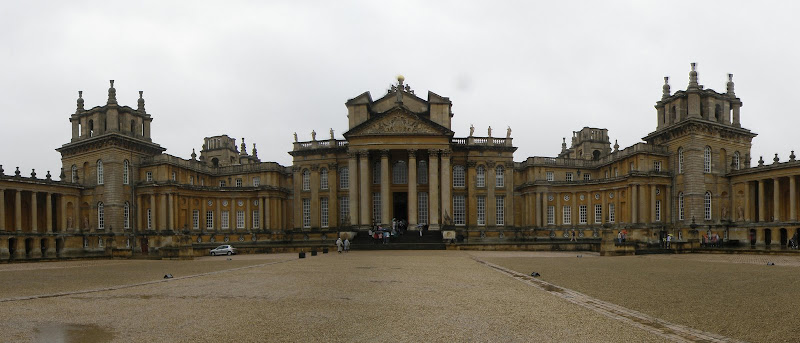
Avoiding the rain we toured the many rooms of the palace, and then we were subjected to a lame audio/video tour giving the history of the palace. We
skipped the gardens due to the weather.
In the pouring rain, we left the Palace that appeared in Harry Potter and the Order of the Phoenix.
Oxford
On the outer edge of the Cotswolds region is the famous University town of Oxford. We arrive right at rush hour, the streets are packed and most of the sights and universities were closed. Yay!
No building in Oxford is newer than 300 years old, so it's still an interesting walk around town.
Heading back towards Chipping Campden, our next stop is Chastleton House, which was built of Cotswold stone in the early 17th century for a wealthy wool merchant. The parking lot is completely empty, and Cows are watching us very carefully as we cross their field.
We pass an old Church and walk up to the front gate. The Jacobean style house is quite striking, but we could only view it from outside the gate, as it is only open certain days... just not today.
Our last stop of the day is Moreton-in-Marsh, where we avoided the rain by having dinner and then headed home. The drive home in the rain was very dark and eery, but we made it safely.
The next morning we had one more stop to complete our grand tour of the Cotswolds, Cirencester. It's another of the classic honey coloured stone villages, but the main attraction is the Church of St. John the Baptist, Often called the 'Cathedral of the Cotswolds'. It is one of the largest and most elegant medieval churches in the county, with a history dating back over 1000 years.
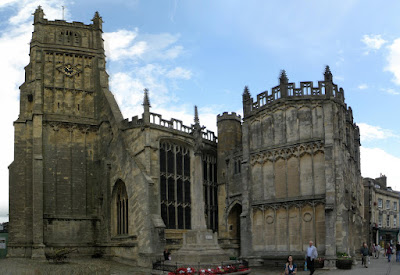
One of the most famous artifacts in the church is the Anne Boleyn cup, so named because it was given by Queen Anne Boleyn to a physician, in thanks for his care of Anne's daughter, the future Elizabeth I. It's gilded silver design makes it look like a trophy, but it's the mix of intricately carved and rough timber ceilings that really deserve most of the attention.
Bath
It's a long drive from the Cotswolds to Bath, by the time we get into the city and find the
TI, we're a little worried about what we may be able to find. Our plan is to find a room for 3 nights, and use Bath as a base for touring the southern part of England. It was a little more expensive, but we find a place that's supposed to be nice in the Sydney Gardens area, a 10 minute walk into town.
We'll check it out after exploring the town for a while, and hope for the best.
Bath was first established as a spa resort with the Latin name, Aquae Sulis ("the waters of Sulis") by the Romans in AD 43 although verbal tradition suggests that Bath was known long before then. The Roman Medieval Baths are what made Bath famous, but the Bath Abbey (The Abbey Church of Saint Peter and Saint Paul)is probably the most striking building you see when you enter the city.
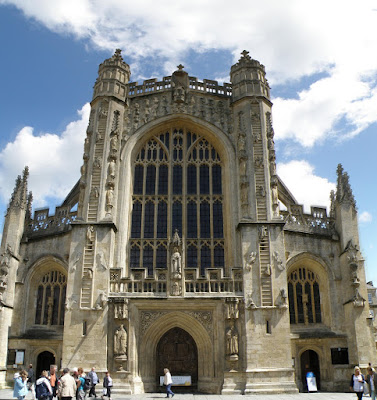
The Abbey was founded in the 7th century and rebuilt in the 12th century to seat over 1200 sheep. Inside is majestic, outside is a mixture of historic and odd statues... don't ask about the rabbit.
Even the much smaller 18th century St. Michael's church is impressive.
But, the real reason people have been coming to Bath for thousands of years is their hot springs, the only naturally occurring ones in all of England. This resulted in a plethora of Roman Medieval Baths and Spas throughout the city, and Bath became known as a place of health and healing.
Being a huge fan of Jane Austen, Norine wanted to ensure that we saw some of the key locations and history of Jane Austen. Bath would be the place, the first stop is the Jane Austen house, where her family lived at one point, and contains a permanent exhibition which tells the story of Jane's Bath experience - the effect that living here from 1801-1806 had on her and her writing.
This neighborhood like every other one, had some majestic townhomes.
None of those homes are quite as majestic as the Royal Crescent and the Circus. The Royal Crescent is a residential road of 30 Georgian houses built in the 1770's, laid out in a crescent. The Circus was built in the 1760's, it's three equal segments form a complete circle, thus the name.
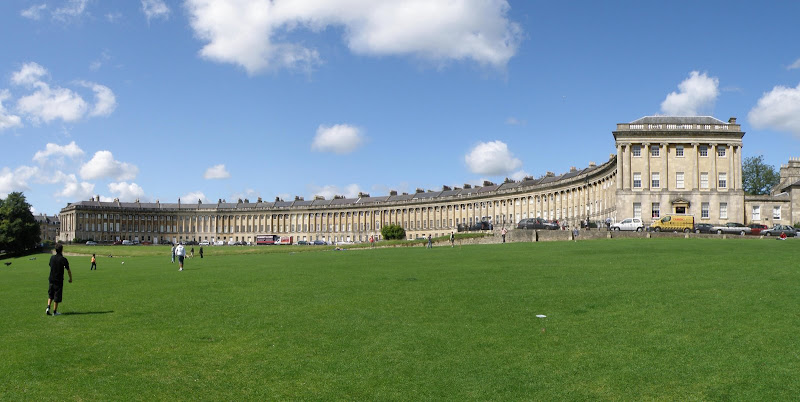
In the middle of town, there is a Medieval wall from the middle ages. I am not sure what it's supposed to protect, but it provides a nice fence for some old buildings.
When we stop in the old market for lunch we are surprised to come across a copy of the newspaper, on the cover is a picture of Keswick. This is where we were in the lake district several days earlier, and now it is flooded. Inside is a picture of a kid in his tent, and a swan is floating through the door of the tent. I guess we shouldn't complain too much about the weather.
The Lake District after we left
After lunch we wandered along the River Avon, yes, that same river from Stratford-upon-Avon. The highlight of the river is the Pulteney Bridge which is based on the Pont Vecchio in Florence. As we are checking out the bridge we watch a nearly tragic event unfold. A seagull floating on the river is sucked into the falls, and instead of going with it, keeps trying to get back up the falls, and is sucked under the water, again and again. We are certain that we are about to witness the sad death of this stupid bird, but can't look away... until finally he grabs a brain, or doesn't have enough energy to try going back up the current, and floats out of the falls, a little worse for wear.
After checking out the colourful interiors of St Johns Church, we walk past the oldest house in Bath, the historical Sally Lunn house, home of the famous Sally Lunn's Buns.
We head back past the historic buildings and Bath Abbey to the parking lot, where we jump in our car (parked next to Herbie), and head to our B&B to see what our home would be like.
As we get closer and closer to our place we quickly start to realize this may be a little beyond our expectations. It's not a B&B, it's a historic townhouse, much like the homes in the Royal Crescent and the Circus. The rooms are huge, the decor is historic and grand, the view is amazing.
The view of our room
The Townhouse we are staying in was used in the Jane Austen movie "Persuasion", A BBC production. The wall decor still retains the set decoration from the period that was used in the movie.
A few doors down is where Jane Austen lived in 1801, and Queen Charlotte lived in the same complex too. I guess we'll be ok staying here for 3 nights.
After settling into our new home , we took the nice 10 minute stroll into town for dinner. We wandered past the historic homes of Jane Austen, Queen Charlotte, Mary Shelley (Frankenstein), Horatio Nelson, and even Napolean III lived on this street for a while before he became "famous".
For dinner we would be surprised by just how good and trendy a restaurant called 'Pizza Express' could be. A great dinner, and a nice walk back as the sun sets on the Bath Abbey.
After coming back to our townhouse, we watched the Jane Austen movie that was filmed there.
It's a little weird sitting in a room watching a movie that takes place in that same room.
One of the unexpected benefits of our townhouse is our hosts, he's English, she's Austrian. So they offer us a choice; Full English Breakfast (again), or an Austrian breakfast of breads, meats, cheeses, and an optional hard boiled egg. It's a very nice break to go Austrian for a few days.
Historical Day Trip
Our first road trip from Bath would be focused on some very historic locations, a circle of the centuries if you will. The first roadside stop is known as the Cherhill White Horse. A 220 ft (67 m) figure was first cut at Cherhill in 1780, and was created by stripping away the turf to expose the chalk hillside beneath. Near the Horse is a 38-metre stone obelisk called the Lansdowne Monument. It was erected in 1845 by the 3rd Marquess of Lansdowne to commemorate his ancestor Sir William Petty, who was an English economist, scientist and philosopher.
The next stop would be more interesting, in the middle of a series of connected sheep fields, stands the neolithic Avebury Stone Circle. Avoiding sheep and their turds, we are free to wander around this 5,000 year old monument, a monument that may be older than Stonehenge. Although the henge is not perfectly circular, it has a diameter of about 420 metres (460 yd). The only known comparable sites of similar date (Stonehenge and Flagstones in Dorset) are only a quarter of the size of Avebury. It's a little odd that a road runs through the middle of the circle.
As we are continuing on to our next stop, it just seems wrong that we would see a 'Tank crossing' sign on the road. We didn't see any tanks, but we were buzzed by helicopters and fighter jets.
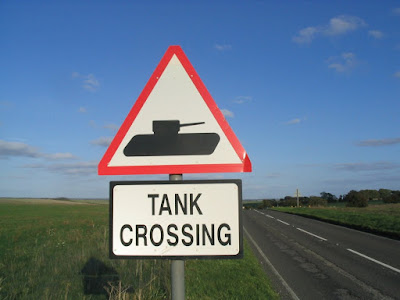
Everybody has heard of Stonehenge, but have you ever heard of Woodhenge? Neither had we until a friend recommended we check it out. 2 miles from Stonehenge is a similar structure from the neolithic or bronze age that contained six concentric rings of 168 wooden posts. It was discovered from an aerial photograph, and each wooden post is now represented by a cement post. Just like Avebury, Woodhenge is in a range of sheep fields, and it's free to explore.
Not free to explore is Stonehenge, you pay to park and enter the site, and you are kept to an outer roped off perimeter. Probably best after seeing how dumb people can be, and it also makes for more scenic pictures without crowds of people leaning on the rocks. Stonehenge is one of the most famous sites in the world, its circular setting of large standing stones and several hundred burial mounds is awe inspiring. Archaeologists believe that it was erected around 2500 BC, but there is evidence of burial mounds and postholes dating back as far as 8000 BC.
It's a little surreal standing at such an iconic place that you have heard of your whole life, and looking to the surrounding hills and seeing pathways that led to this site, and realizing that those hills are actually burial mounds. Why was it built, what was it used for, and why did generation after generation of people maintain and restore this monument for thousands of years?
From prehistoric to gothic, our next stop is Winchester Cathedral, one of the largest cathedrals in England, with the longest nave and overall length of any Gothic cathedral in Europe. The cathedral was originally founded in 642 AD, with construction of the new cathedral starting in 1092.
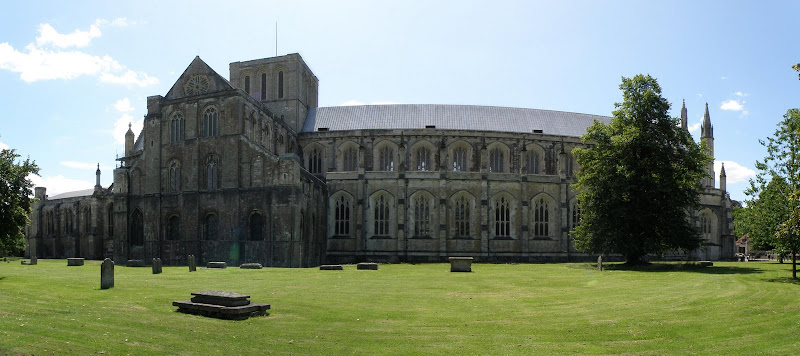
Our Jane Austen historical tour continues here, as this is where she was buried in 1817.
The building was used as a film set for the The Da Vinci Code with the north transept used as the Vatican. Following this the cathedral hosted discussions and displays to debunk the book.
A short walk from Winchester Cathedral is the Wolvesey Castle ruins, a castle built by the Bishop of Winchester between 1130 and 1140. The castle was destroyed by Parliamentarians during the English Civil War against Royalist supporters of King Charles I of England in 1646.
After stopping to admire the wildlife, we headed back into the town of Winchester, and admired the Gothic style of the Winchester Guildhall built in 1871 before leaving.
Statue of King Alfred the Great in Winchester
The next stop on our historical circle is the Salisbury Cathedral. The Early English gothic style cathedral took 38 years to build and was completed in 1265, it has the tallest church spire in the U.K. (123m/404ft), and has one of the four surviving original copies of the Magna Carta. Although commonly known as Salisbury Cathedral, the official name is the Cathedral of Saint Mary.
Old and new are on display in the cathedral, a modern reflecting pool is a centerpiece that stands in contrast to the medieval clock. The clock dating from about 1386 is the oldest working clock in the world, it has no dial or face, but rang a bell on the hour.
After two Cathedrals in a row, we needed to mix it up a bit so we headed to the town of Glastonbury so we could see the Abbey ruins. From Cathedrals to Abbeys, that's how we mix things up. Unfortunately we arrived right after it closed, and it is secluded behind walls. We decided to walk around the walls to see if we can get a look at the ruins, and ended up walking through an odd mystic town. Fortune tellers, tattoo shops and mystic gem shops, form the core principles of this hippy like town, it's actually a little creepy in a cult movie kind of way.
Since at least the 12th century the Glastonbury area was frequently associated with the legend of King Arthur, a connection promoted by medieval monks who asserted that Glastonbury was Avalon. The monks even stated they found the buried remains of King Arthur and Guinevere in 1191, but somehow those disappeared during the restoration period.
At the far end of the town we find the Abbey retreat house, which is now used by the Diocese. It is closed to the public, but we snuck into the backyard so we can see the abbey ruins. We watched the windows of the Diocese's house to make sure we wouldn't get caught, and got to see the Abbey. The Abbey dates at least to the early 7th century, later medieval Christian legend claimed that it was founded in the 1st century. This legend is intimately tied to the story of the Holy Grail.
The rain started up again, so we headed back to the car and made our way to our last planned stop. If we had of arrived in time we may have finally got to experience Evensong (church choir).
We didn't arrive on time and Wells Cathedral is locked up tight. We can't even look inside, so we check out the outsides of the Cathedral and the other unique medieval style buildings in Wells. The town hall and market square area look like the entrance to a castle, you pass through the doors into the grounds of Wells Cathedral, aka the Cathedral Church of St Andrew.
Built between 1175 and 1490, Wells Cathedral has been described as “the most poetic of the English Cathedrals”. It has a very unique look with intricate carvings and sculptures.
Through the Arch and next to the Cathedral is Vicars Close, the oldest continuously inhabited medieval street in Europe, built in 1348 to provide 42 bachelor homes for the "Vicars' Choral" (choir). Each house contained one room downstairs and another upstairs, linked by a rear turret.
From the cathedral we walked over to the Bishops Palace, a medieval castle looking building including a moat. Funny thing happens on a cloudy evening, I take a picture of a large group of ducks in the moat with the Flash turned on, and all of a sudden every last duck is filing out of the water. They must have thought my camera flash was lightning... Weird. Mixed in with the ducks is a couple of geese and swans, apparently the swans have been trained to ring a bell for food.
Food... good idea, it has started raining again, so it's a good time to have some dinner and avoid the rain. I had the most amazing Pork loin dinner, probably would say it was the best meal of the whole trip. After dinner we had a very harrowing drive back to Bath in the dark and the rain.
Seaside Day Trip
When we wake up it's still raining, but today we're going to the beaches on the Southern shores of England. The further we drive from Bath, the less it is raining, that's a good sign. We're cruising along the major Motorway towards the coast, (sound of squealing tires) and suddenly we are in a traffic jam of epic proportions. For an hour we barely crawl, until I finally see the source, 3 cars have run into each other on an entrance ramp, and our traffic is basically stopped because of looky loos. You would think that the English would be more educated in driving after all these years.
After getting past the traffic we end up in the coastal town of Plymouth and it's large busy harbour. In 1620 the Pilgrims left Plymouth on the Mayflower for the New World and established Plymouth Colony — the second English settlement in what is now the United States of America.
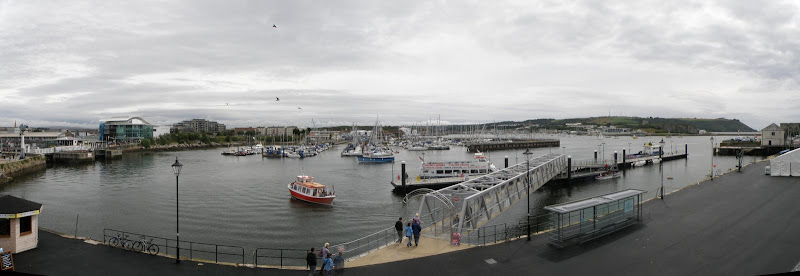
On the hill above the harbour is the Royal Citadel, established in the 17th century as Plymouth was a key defensive position. The hillside itself is called the Hoe, you can only imagine how many jokes we made as we wandered through Plymouth and saw the 'Hoe' signs.
Prominently displayed on the Hoe is Smeaton's Tower lighthouse originally built on eddystone rocks in 1759. It was dismantled in 1877 and moved, stone by stone, to the Hoe. The views across the harbour are amazing, it would all feel very peaceful if it wasn't for the massive Carnival that is setup in the main courtyard, next to the Naval War Memorial is the Tilt-a-Whirl.
From the Hoe we wandered back down into the town, and bought some wraps for a quick lunch while we sat in the busy marina. We need to get somewhere a little more laid back.
St Matthews Church on Brixton Green (1822)
From Plymouth we worked our way along the coast, and into the hillside town of Dartmouth. Located on the River Dart estuary, the steep slopes of the town create a quaint village feel. It's especially noticeable as Austin sends us down a super narrow and super steep road to the waterfront area of the town. It's a little harrowing with sharp corners and very little room,
but the trip down was well worth it to see this cute little town.
We followed a trail of wedding confetti to St Saviour's Church. The Church dates back to 1372, but the priest was very proud to show us the "new" medieval ironwork door that was made in 1631.
From the waterfront you can catch a ferry to the 14th century Dartmouth Castle, the sign says it's only 2£ for the ride to the Castle. When the boat pulls up, we realize it's not much bigger than my dad's fishing boat. Nothing like immersing yourself in with the local fishermen making a buck.
Dartmouth Castle is one of a pair of forts, the other being Kingswear Castle, that guard the mouth of the Dart Estuary. During the 100 year war, they used to run a chain between the castles at night after the town was sacked a few times. The gun towers and platforms continued to be used until the 19th century, and were still in use during World War 1 and 2.
As we are leaving Dartmouth and working our way along the coast, we pass a sign for Wolford Chapel with a Canadian flag on it. What is this place? Apparently Wolford Chapel is the burial place of John Graves Simcoe, the first lieutenant governor of Upper Canada in 1806. It is the property of Ontario, and flies the Flag of Canada despite being in the English countryside.

When staying at a B&B or other style of guesthouse, it is always a good idea to ask the hosts about what sights and nearby attractions they recommend, you never know what unknown jewel or unique town you may find that you hadn't heard of before you left.
Recommended to us, is the resort town of Lyme Regis. Lyme Regis appeared in the Jane Austen movie 'Persuasion' that we just watched, and was also a setting for the movie 'The French Lieutenant's Woman', where Meryl Streep stood, looking out to sea. We have to park near the top of town, then walk down the steep hill into the village along a River walk that leads to the beach.
At the bottom of the path, a few steps take us out onto a beautiful rocky beach. At the far end of the rocky beach, close to a scenic breakwater harbour wall, is an even nicer sandy beach.
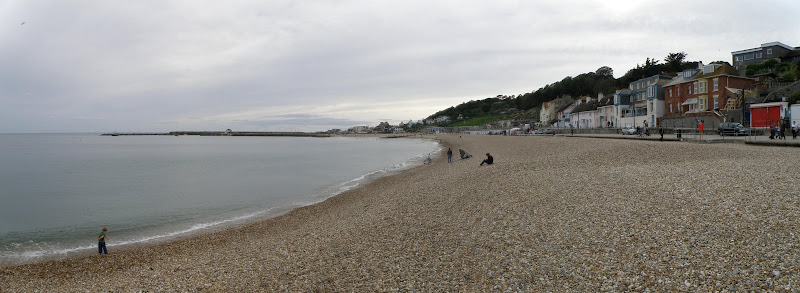
All along the beach is a parade (promenade), with colourful shelters that can be rented. The parade leads to a Stone harbour wall and breakwater known as the Cobb. We walk along the parade just like in the Jane Austen movie, pausing to watch these crazy bike kids climb walls that they shouldn't be able to climb with a bike. It looks even crazier when they jump back off. I am guessing that is why their bikes don't have any seats. As we walk along the Cobb, we overhear a funny conversation based on the smelly seaweed... "It's a natural smell honey, it wasn't the dog".
After a lovely afternoon on the waterfront at Lyme Regis, we wandered through the historic old town, before heading inland towards Bath. We'll stop in Dorchester for dinner along the way.
Historic downspouts in Lyme Regis old town
When we get into the supposed market town of Dorchester, you would swear the town has been evacuated. The pedestrian street is vacant, and everything is closed. There was a couple nice buildings, but if it's after 8:00 apparently you can't eat here. What a waste of a town.
Since we couldn't have dinner here, we jumped back into our car, hoping we would pass somewhere else worth stopping. As it got darker and later, we quickly realized we would be back in Bath and having a Cookie and Chip dinner tonight... lesson learned. Have dinner before 8:00pm.
One last Austrian breakfast and we pack up and head East to the Welsh border.


